Program Synopsis
Designed to improve fruit and vegetable intake and the home nutrition environment for low-income first-graders and their parents, this school- and home-based intervention provides fresh produce, health education, and healthy food tastings. The study showed an improvement in diet and nutrition behaviors.
Program Highlights
Program Materials
Preview and order the materials from the developer
Program Scores
The Need
In the United States, childhood obesity has risen over the past 20 years, contributing to negative immediate and long-term health outcomes. Many children can maintain a healthy weight by having healthy eating habits and engaging in physical activity. Children living in low-income areas generally have less access to affordable healthy foods (e.g., fruits, vegetables). Schools can play a critical role in improving the dietary and physical activity behaviors of children and adolescents. Schools can create healthy environments by implementing policies and practices that support healthy eating and regular physical activity and by providing opportunities for students to learn and practice these behaviors. Because a high-quality diet and physical activity are associated with improved school performance, a healthy school environment can also support academic achievement.
The Program
Brighter Bites is designed to help first-graders and their parents improve their diet and nutrition practices. Available in English and Spanish, this 16-week program is based on the social cognitive theory and the theory of planned behavior. The program has three components:
--Distribution of fresh food: Each week, the Brighter Bites coordinator manages the delivery of 50 to 60 servings of fresh produce, donated by local food banks, to each family.
--Health education: Schools deliver Coordinated Approach to Child Health (CATCH), an EBCCP-reviewed program. Parents receive two handbooks in both English and Spanish that address nutrition and other health topics (e.g., food preparation techniques, food storage and safety, menu planning, food purchasing, breakfast consumption, nutrition label reading, eating out, establishing family mealtimes, physical activity, tobacco use prevention, healthy meals and snacks) as well as weekly recipe cards featuring the produce delivered that week. Teachers lead interactive CATCH activities at school and provide homework for the parents and children. Schools also host CATCH events for families.
--Healthy food tastings: Once per week, when parents are picking up children at the end of the school day, the coordinator and volunteers prepare fresh healthy meals for the parents and students to taste.
Time Required
The intervention is 16 weeks total (8 weeks in the fall and 8 weeks in the spring).
Intended Audience
The intervention is intended for low-income first-graders and their parents.
Suitable Settings
The program is suitable for implementation in school and home settings.
Required Resources
Required resources to implement the program include the following:
https://www.brighterbites.org/
For costs associated with this program, click on Contact the Program Developer on the Program Materials page.
About the Study
A nonrandomized comparative study used a delayed intervention design over a 2-year period. In year 1, three schools were assigned to the intervention group and received Brighter Bites, and three schools were assigned to the comparison group and received CATCH; first-grade parent-child dyads were recruited from the six schools. In year 2, the schools from the comparison group moved to the intervention group and received Brighter Bites, and three new schools were assigned to the comparison group to receive CATCH; new first-grade parent-child dyads were recruited from the six schools. All nine schools were public and charter schools that enrolled first-grade children and had more than 75% of children in the school receiving free/reduced lunch. Enrollment was limited to one parent-child dyad per family. In total, 717 parent-child dyads enrolled (n=407 intervention, n=310 control).
Across the two groups, the average age of children was 6 years. For the parents in the dyad, the average age was 34 years, 90% were mothers, more than 70% were Hispanic, and 49% were employed. More than half of the households (54%) were bilingual.
The primary outcomes, measured at baseline, at 8 weeks (the midpoint of the intervention) and at 16-week follow-up (after the intervention), were daily servings of fruits, vegetables, and added sugar consumed by the child; daily servings of fruits consumed by the parent; using nutrition facts labels to make grocery purchasing decisions; and cooking using basic ingredients. Dietary intake was measured for the children using the Block Kids Food frequency questionnaire and for the parents using the 10-item Fruits and Vegetables Screener. Parents completed a self-report questionnaire to indicate how often they used nutrition facts labels (measured with a 5-point Likert scale from “rarely” to “always”) and how often they cooked using basic ingredients (with response options of “once per day or more often” and “less than once per day”).
Key Findings
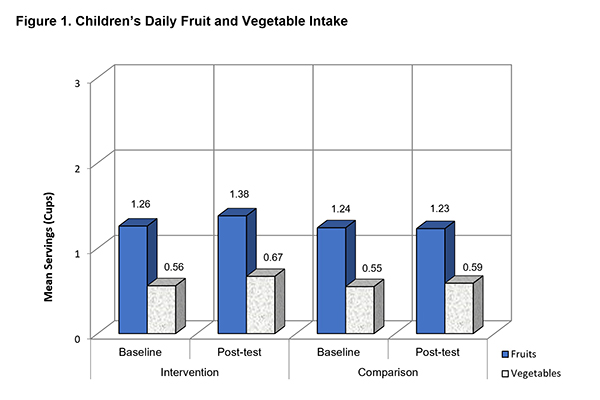
-
From baseline to post-test, intervention group children had an increase in fruit intake, while comparison group children had a decrease (p=0.046). Intervention group children had a greater increase in vegetable intake than did comparison group children (p=0.049).
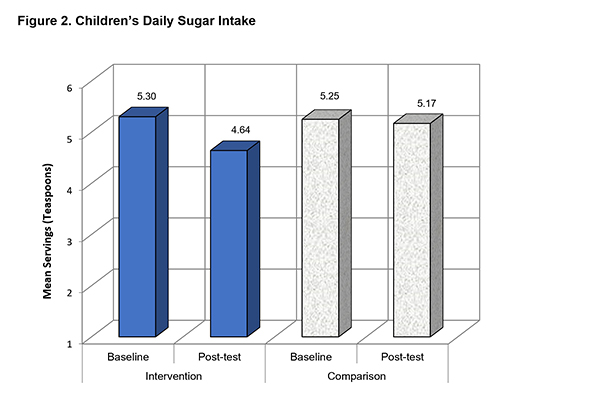
-
From baseline to post-test, intervention group children had a greater decrease in sugar intake than did comparison group children (p=0.014).
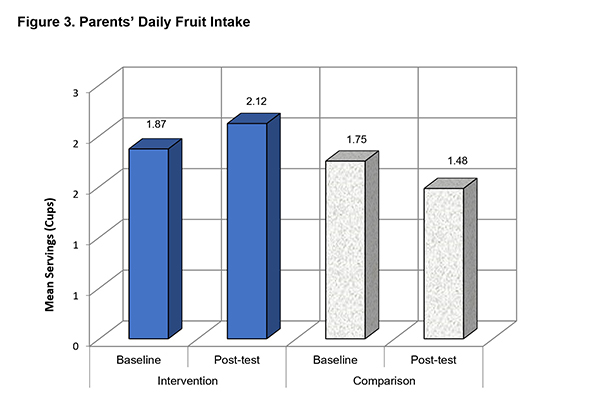
-
From baseline to post-test, intervention group parents had an increase in fruit intake, while comparison group parents had a decrease (p=0.013).
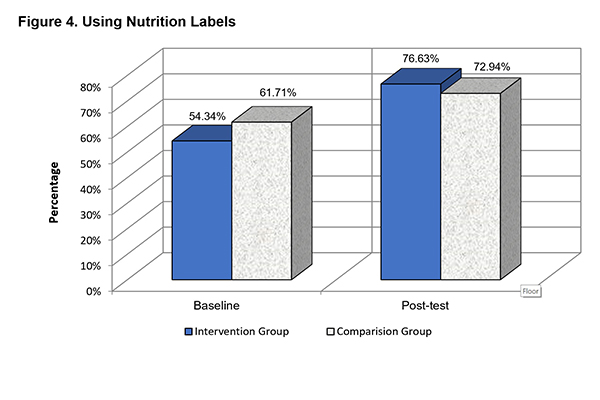
-
From baseline to post-test, the percentage of parents who always or often used nutrition labels to make grocery purchasing decisions increased more in the intervention group than in the comparison group (p=0.019).
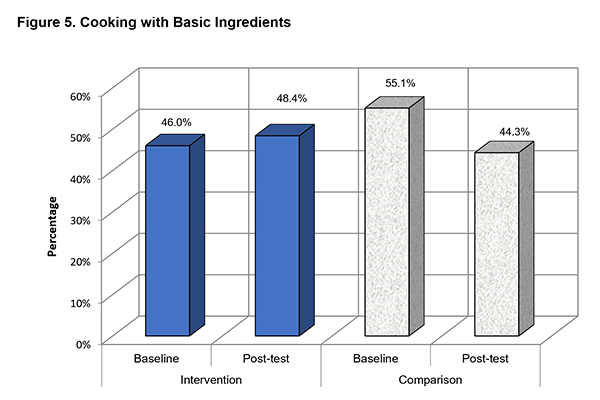
-
From baseline to post-test, the percentage of parents who cooked with basic ingredients at least once per day increased in the intervention group and decreased in the comparison group (p=0.007).


